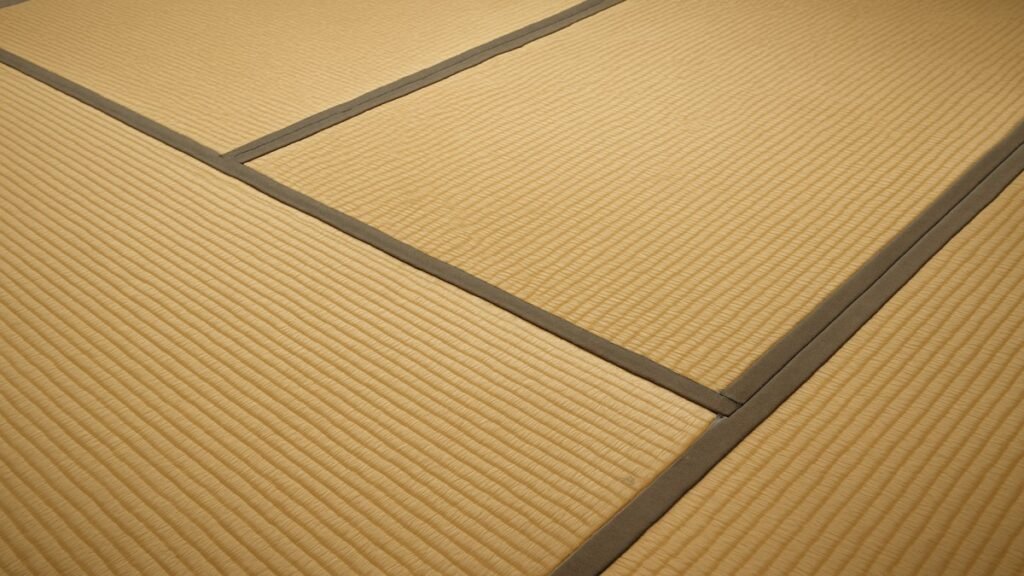Introduction to Tatami Mats
Mats Tatami. Have you ever walked into a traditional Japanese room and noticed the soft, woven flooring beneath your feet? That’s Tatami, one of Japan’s most iconic cultural symbols. These mats are more than just flooring; they represent tradition, harmony, and comfort in Japanese homes.
What are Tatami Mats?
Tatami are traditional Japanese mats made of rice straw and woven rush (igusa) on the surface. They are rectangular, firm yet slightly soft, and often used to cover entire rooms.
Why Tatami is Unique in Japanese Culture
Tatami defines the layout of a room. Even today, rooms in Japan are measured not in square meters but in “jo,” which refers to the number of Tatami mats that fit inside.
The History of Tatami
Origins in Ancient Japan
Tatami first appeared around the Nara period (8th century). Initially, they were luxury items reserved for nobility.
Tatami in Samurai and Aristocratic Houses
By the Heian era, Tatami became a mark of social rank. Samurai and aristocrats used Tatami not only for comfort but also as a symbol of prestige.
Transition to Common Use
During the Edo period, Tatami gradually spread to ordinary households. Today, while many modern Japanese homes use wooden floors, Tatami remains popular for bedrooms and traditional rooms.
Traditional Design of Tatami Mats
Structure and Materials Used
Traditional Tatami has a core of rice straw, covered with soft woven rush grass, and bordered with cloth. This combination makes them breathable and natural.
Standard Sizes and Proportions
Tatami mats have a standard size: about 90 cm x 180 cm (varies by region). Rooms are often described by the number of mats they can hold, like “6-mat room.”
Variations Across Japan
Different regions of Japan have slightly different mat dimensions, which influence architectural styles.
Symbolism and Cultural Importance
Role in Tea Ceremonies
Tatami is inseparable from the Japanese tea ceremony. The mats set the stage for simplicity, discipline, and spiritual reflection.
Spiritual and Zen Influence
In Zen Buddhism, Tatami rooms are designed to encourage calmness and focus. The natural smell of igusa grass enhances mindfulness.
Respect and Etiquette of Tatami Spaces
Shoes are strictly forbidden on Tatami. Even walking on Tatami requires grace and respect, reflecting Japanese etiquette.
Modern Uses of Tatami Mats
Tatami in Contemporary Japanese Homes
Although modern apartments rely on hardwood or carpet, Tatami rooms (washitsu) are still cherished for sleeping or relaxation.
Martial Arts Dojos and Training Halls
From Judo to Aikido, Tatami provides a safe, cushioned surface for practice. Martial arts practitioners trust its durability and comfort.
Interior Design and Global Adaptation
Tatami-inspired flooring is now popular worldwide, especially among minimalists who admire its clean and natural look.
Benefits of Tatami Mats
Health and Comfort Advantages
Tatami is breathable, helping regulate humidity. It’s also firm enough to support posture yet soft enough to sleep on comfortably.
Environmental Sustainability
Made from natural, renewable materials, Tatami is eco-friendly and biodegradable.
Aesthetic and Minimalist Appeal
Tatami’s natural green tone creates a peaceful ambiance, perfect for meditation and relaxation.
Care and Maintenance
Cleaning Practices
Tatami should be cleaned with a dry cloth or vacuum. Wet cleaning is discouraged since moisture can damage the rush grass.
Preventing Mold and Damage
Placing Tatami in well-ventilated areas helps prevent mold. Direct sunlight should also be avoided to prevent fading.
When to Replace a Tatami Mat
On average, Tatami lasts 5–10 years depending on use. The surface cover (omote) can be replaced without discarding the entire mat.
Conclusion
Tatami mats are not just flooring; they are a lifestyle. Rooted in history, symbolism, and craftsmanship, they continue to play a vital role in Japanese homes, martial arts, and design worldwide. Whether you’re drawn to their spiritual significance or simply love their comfort, Tatami brings a touch of Japan’s timeless elegance into your life.
FAQs
1. Can Tatami be used in humid climates?
Yes, but proper ventilation is essential to prevent mold. Synthetic Tatami is recommended in high-humidity regions.
2. How long do Tatami Mats last?
Typically 5–10 years, depending on care. Replacing just the surface can extend their life.
3. Are Tatami Mats safe for children?
Absolutely. They are soft, non-toxic, and provide a safe surface for kids to play or sleep on.
4. What is the smell of fresh Tatami?
Fresh Tatami has a calming grassy scent that many describe as refreshing and relaxing.
5. Can Tatami Mats be used outside Japan?
Yes! Many international homes, yoga studios, and meditation spaces incorporate Tatami for comfort and authenticity.








